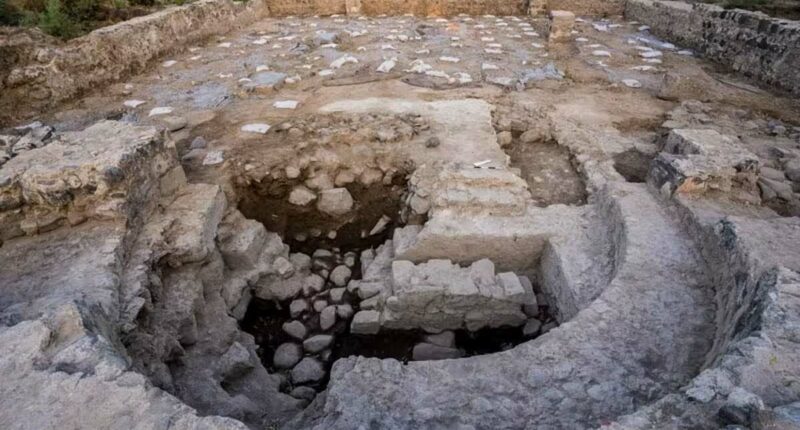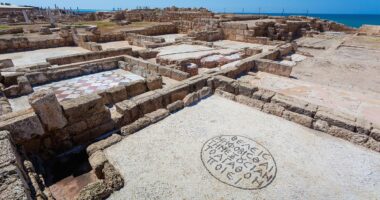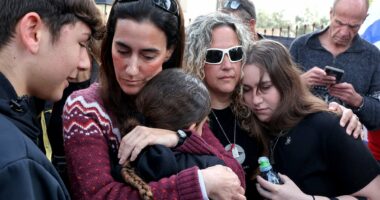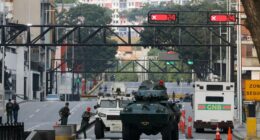Share this @internewscast.com

A recent wildfire in Israel has revealed ancient ruins, shedding light on what may be the hometown of Jesus’ apostles from 2,000 years ago. Archaeologists uncovered the site at El-Araj, on the northern shore of the Sea of Galilee, which may be Bethsaida, the fishing village where Peter, Andrew and Philip lived. The Book of John 1:44 reads: ‘Now Philip was from Bethsaida, the city of Andrew and Peter.’

The wildfire, which swept along the northern shore in late July and forced swimmers to flee, tore through the Betiha Nature Reserve, clearing dense vegetation and exposing small mounds scattered across the archaeological site. Mordechai Aviam, director of the excavation from Kinneret College, said: ‘The fire, while tragic, has allowed us to survey areas that were previously inaccessible due to thick vegetation.’ The scorched ground revealed hundreds of feet dotted with earthen mounds, each potentially marking ancient rooms .

The fire also revealed previously hidden walls, mounds where buildings once stood, and fragments of pottery dating back to the Roman era, when Jesus lived and ministered. The excavation, now in its ninth season, focused on reaching the Roman layer, buried beneath Byzantine and Crusader remains. Aviam suggested the layer existed, citing fragments of Roman pottery and the earlier discovery of a Roman bathhouse, a hallmark of urban life in that era. The wildfire exposed new areas, guiding archaeologists to promising sites for future digs.

The team discovered a pillar drum indicating the presence of a formal Roman-style public building, Haaretz reported. These Roman-era artifacts and architectural features suggested that the village had been upgraded to a city under King Herod Philip, aligning with historical records of Bethsaida. Those artifacts included fishing tools and the remains of a Roman bathhouse, indicating that the area had once been a thriving settlement.

These findings aligned with descriptions from ancient texts, including those of the historian Josephus, who was known for his firsthand accounts around the time of Jesus. One of his ancient passages even describes Jesus, saying: ‘Now there was about this time Jesus, a wise man, if it be lawful to call him a man. For he was a doer of wonderful works, a teacher of such men as receive the truth with pleasure.’ Above the Roman layer lay remnants of a Byzantine church and monastery from the 5th century, over which Crusaders later built a sugar factory.

The church contained a mosaic bearing the name of Peter as ‘the chief and commander of the heavenly apostles.’ In 2022, Zachary Wong, an audio engineer from Hong Kong who first joined the project in 2016, helped uncover the mosaic, which forms part of a larger floor in the church’s diaconicon, decorated with floral patterns and framed with a round medallion of black tesserae. Steven Notley, an archaeologist with Nyack College in New York and part of the dig, said, ‘This discovery is our strongest indicator that Peter had a special association with the basilica, and it was likely dedicated to him. Since Byzantine Christian tradition routinely identified Peter’s home in Bethsaida, and not in Capernaum, as is often thought today, it seems likely that the basilica commemorates his house.’

The ruins of the church also align with the account of Saint Willibald, a Bavarian bishop who visited the area around 725 AD during a pilgrimage. He reported that a church had been built on the site of Peter and Andrew’s home, describing Bethsaida as lying between the biblical sites of Capernaum and Kursi. Archaeologists have not definitively confirmed the exact location of St Peter’s birthplace, noting inconsistencies in biblical accounts about where Peter and Andrew lived.Christians recognize St Peter, originally Simon Peter, as a fisherman and one of the first followers of Jesus, later appointed the leader of the early Church following Jesus’ ascension.

Peter is famously known for cutting off a Roman soldier’s ear when Jesus was arrested by order of Pontius Pilate, the fifth governor of the Roman province of Judea, serving from 26 to about 37 AD. Luke 22:54–62 recounts how Peter denied knowing Jesus three times after the crucifixion. According to Christian tradition, Peter later died a martyr in Rome during the reign of Emperor Nero around 64 CE, crucified upside down because he felt unworthy to die in the same manner as Jesus Christ.







